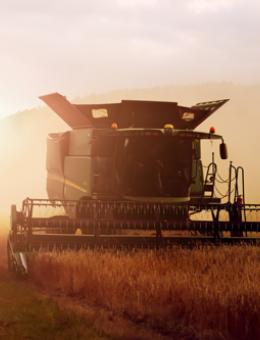
MARKET VOLATILITY MAKES SHARE FARMING AGREEMENTS WORTH A CONSIDERATION
Published 28 July 2023
Although last year’s harvest is a distant memory, it is only in recent weeks that the final harvest contract agreements have been tied up, as although the crops may be harvested in late summer, they are often not finally sold until late spring the following year, writes Simon Evans.
This year, with massive volatility in both output prices paid and the cost of inputs such as fertiliser, the question of when to sell harvested crops has been more front of mind than for many years.
Wheat prices were around £130 per tonne two years ago, then ballooning to over £300 a tonne in the last twelve months now falling back to less than £200 a tonne. Clearly selling at the right time, or securing the right forward deal, is central to ensuring farm is profitability.
This is a real issue for landowners who don’t physically farm their own land, because the nature of the contract they have will determine how much – or how little – say they have in making that decision about when the farm’s outputs are sold.
There are essentially three different options available to landowners who wish to retain their asset manage tier estate but withdraw from the practical farming activities.
The first is a simple farm tenancy, which is the lowest risk approach: the landowner receives a fixed rent, no matter how profitable or otherwise the farm ends up being.
The most common approach is a contract farming arrangement, in which the landowner pays a fee to the contractor to do the actual work, with an additional bonus paid depending on the performance of the business. The downside to this arrangement is that the landowner has to finance the business, and with soaring interest rates, that has become a real issue.
There is a third way, which is often overlooked by landowners seeking to outsource the actual farming on their land, and that is a share farm agreement. Here the landowner is responsible for the land, buildings and maintenance, while the share farmer (i.e., the contractor) provides the labour and expertise, and finances the field machinery. Input costs are split between the two on an agreed percentage.
The reward to the farming activity is the output of the farm and the benefit to the landowner of the share farming approach is that the outputs are also split, allowing the landowner to sell their share when and how suits them, not the contractor.
With rising interest rates and uncertain output prices, the shared farming model is one which more landowners could consider, because it allows them to take control of their own destiny.
Share this story
Arnolds Keys Blog

DEMAND FOR FREEHOLD COMMERCIAL PROPERTY REMAINS RESILIENT
19 July 2023
So interest rates have risen for 13 consecutive months, now standing at 5%, writes Nick O'Leary. Read more >

WHY REGULAR RENT REVIEWS ARE BETTER THAN ONE BIG SHOCK
14 July 2023
Few people will be unaware of the looming cliff-edge for home-owners and landlords, with fixed rate mortgage deals coming to an end, with swingeing increases in monthly payments, writes Catherine Hunt. Read more >

DAMPING DOWN THE RISK OF HARVEST FIRES
1 July 2023
As harvest approaches and the dry, sunny spell of weather continues, the ever-present threat of farm fires should be on everyone’s mind, writes James Hill. Read more >

ATMOSPHERIC OIL PAINTING OF FAMILIAR NORTH NORFOLK VIEW CARRIES OFF NORFOLK SHOW ART PRIZE
30 June 2023
An atmospheric oil painting of Brancaster Staithe has carried off the prestigious Sponsor’s Choice Award at the Royal Norfolk Show Art Exhibition this year – recognising the work of a... Read more >
